Kind of reminds me of RAAL's Requisite Eternity omni.
RAAL Requisite Eternity Omni-Directional Speaker System | Tuvie

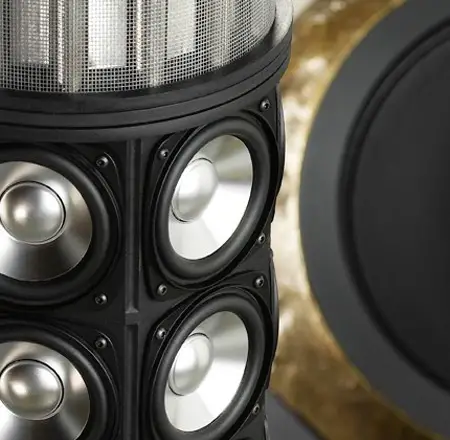
That's a solid bronze casting that holds the woofers on the bottom.
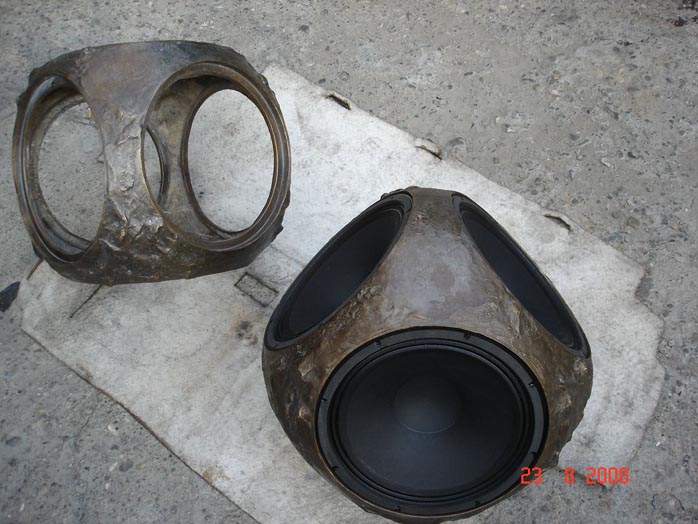
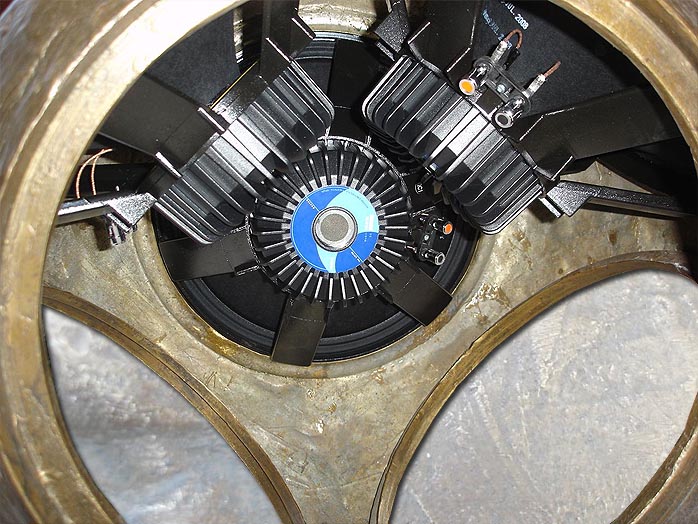
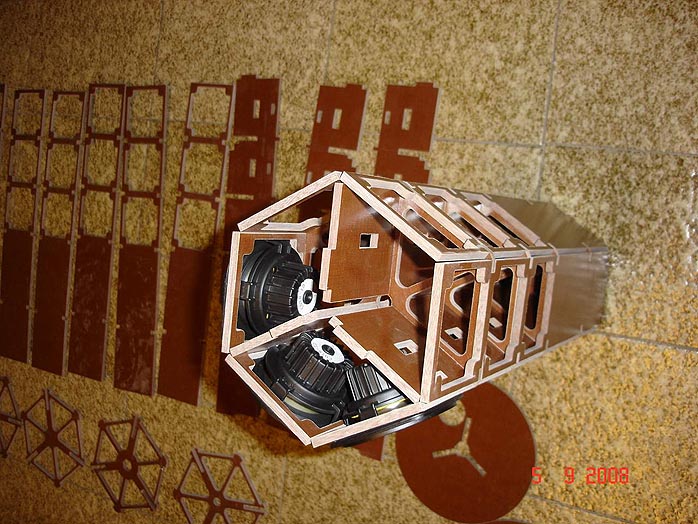
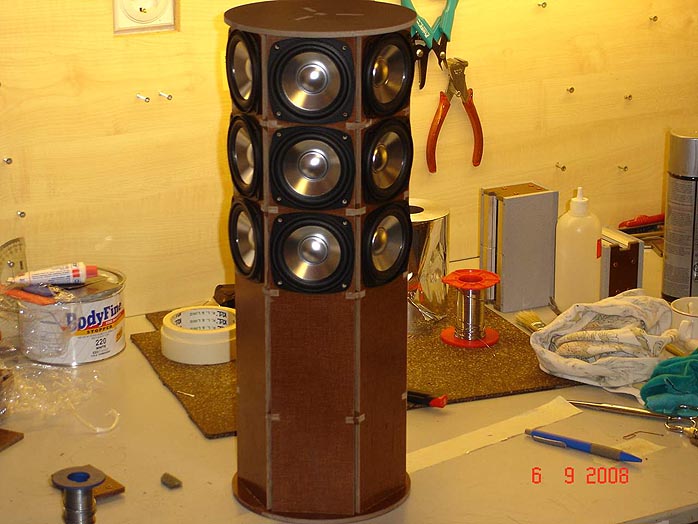
The best part is the polar array of RAAL ribbons on top.
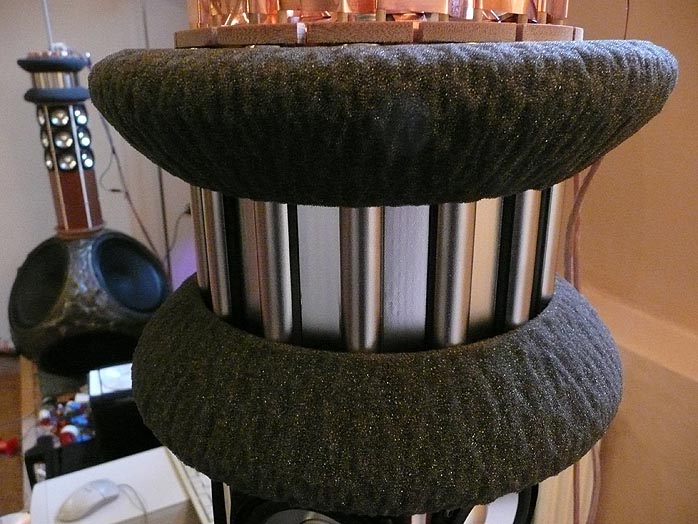
RAAL Requisite Eternity Omni-Directional Speaker System | Tuvie


That's a solid bronze casting that holds the woofers on the bottom.




The best part is the polar array of RAAL ribbons on top.

I posted a comment on the designer's blog and he was kind enough to add me to the reviews: BeoLab 90 reviews earfluff and eyecandy
That's awesome
I proposed that idea of a 3 sided array too, posted here: http://www.diyaudio.com/forums/full-range/274020-all-aspiring-full-range-array-project-26.html#post4477394
Seemed like a very cool idea after "getting" the concept of what B&O were doing 🙂. Now I'm not complaining about my DSP/Array results, not at all actually 🙂, but it would be fun to be able to narrow the directivity to avoid having to treat the walls. I bet this 3 sided array would make a great speaker though.
Here's my one concern in what B&O are doing as apposed to what could be accomplished with less discreet channels is too much DSP filtering. Like it or not fellas, with each digital filter is an accompanying ring..........18x....that's a lot of ringing for those of us that are sensitive to it.
Now if we take your iteration, reduce the driver size ( to reduce combing😜),offset each vertical driver slightly ( reducing combing some more and steer the lobes off axis😝) we could try resistive venting on the sides. Considering that beaming will occur and the resistive vents will mechanically filter high frequency, we just might end up with a fairly consistent directivity plot.
The B&O design doesn't do much for vertical directivity except for maybe above the HF low pass utilizing the top tweeter phase control. I would imagine they deemed it insignificant in their listening tests so a subjective decision?......
Here's my one concern in what B&O are doing as apposed to what could be accomplished with less discreet channels is too much DSP filtering. Like it or not fellas, with each digital filter is an accompanying ring..........18x....that's a lot of ringing for those of us that are sensitive to it.
Now if we take your iteration, reduce the driver size ( to reduce combing😜),offset each vertical driver slightly ( reducing combing some more and steer the lobes off axis😝) we could try resistive venting on the sides. Considering that beaming will occur and the resistive vents will mechanically filter high frequency, we just might end up with a fairly consistent directivity plot.
The B&O design doesn't do much for vertical directivity except for maybe above the HF low pass utilizing the top tweeter phase control. I would imagine they deemed it insignificant in their listening tests so a subjective decision?......
The ringing would depend a lot on the FIR filters that they use and the implementation. I can't imagine that there would be much audible ringing with 96KHz processing. As well, I would expect destructive interference to occur with the ringing as well.
Ringing is caused by abruptly cutting off frequency components that you can't hear from a fast edge. If those components are where you could hear them, then your filter cutoff is too low. Sample and filter higher till you get to where only filter components you wouldn't hear are removed. There will still be ringing... Then back to the first sentence 🙂
Kind of reminds me of RAAL's Requisite Eternity omni.
RAAL Requisite Eternity Omni-Directional Speaker System | Tuvie

I like the pic of the speaker being ridden on. Reminds me of a Segway. 😀
It occurs to me, that the speakers available today that could most implement beem steering are also the speakers that will least need it, such as this McIntosh line array. (never head one, btw).
Thanks to having so many mid and tweeter drivers, it could easily implement beam steering with the appropriate amplification. However, also thanks to it's design as a line array, probably doesn't need it at all.
An externally hosted image should be here but it was not working when we last tested it.
Thanks to having so many mid and tweeter drivers, it could easily implement beam steering with the appropriate amplification. However, also thanks to it's design as a line array, probably doesn't need it at all.
the more i read on forums the more convinced i become of the fact that virtually no audiophiles understand dispersion patterns. advice range from A to Z, with little thought into how instruments and real life sounds behave. instead its speaker vs speaker with the foundation of a typical speaker. even some designers with polars as the absolute first priority continuely misunderstand the concept of dipoles for instance.
not that i know any better for that matter, but physical models are what they are and should not be under interpretation when its done correctly, such as listening "studies" with conclutions all over the map. i wonder how often linkwitz rolls his eyes in frustration...
not that i know any better for that matter, but physical models are what they are and should not be under interpretation when its done correctly, such as listening "studies" with conclutions all over the map. i wonder how often linkwitz rolls his eyes in frustration...
It occurs to me, that the speakers available today that could most implement beem steering are also the speakers that will least need it, such as this McIntosh line array. (never head one, btw).
An externally hosted image should be here but it was not working when we last tested it.
Thanks to having so many mid and tweeter drivers, it could easily implement beam steering with the appropriate amplification. However, also thanks to it's design as a line array, probably doesn't need it at all.
I listened to the Genesis arrays twice, and they were the last speaker that I listened to before I listened to the Beolab 90s.
Here's some things I noticed:
1) the difference in the bass in noticeable immediately. The Beolab bass sounds very much like a dipole. The bass from the Genesis sounds like everything else.
2) I'm really starting to thing that horizontal arrays are underrated. The Genesis is dynamic, but it basically sounds like a conventional two way speaker. The main difference with the Genesis is that the stage doesn't change much as you move around; I tried two different seating positions and they were largely similar.
In a nutshell, I think that doing a horizontal array makes the sweet spot much smaller, but if you 'lock in' to the correct location you can really get that 'giant headphone' effect where you feel like you're transported to the recording venue.
Vertical arrays can raise the dynamics and eliminate the 'floor bounce', but I'm beginning to think that eliminating sidewall reflections is where it's at. Then again a proper waveguide can eliminate both 🙂
I listened to the Genesis arrays twice, and they were the last speaker that I listened to before I listened to the Beolab 90s.
Here's some things I noticed:
1) the difference in the bass in noticeable immediately. The Beolab bass sounds very much like a dipole. The bass from the Genesis sounds like everything else.
2) I'm really starting to thing that horizontal arrays are underrated. The Genesis is dynamic, but it basically sounds like a conventional two way speaker. The main difference with the Genesis is that the stage doesn't change much as you move around; I tried two different seating positions and they were largely similar.
In a nutshell, I think that doing a horizontal array makes the sweet spot much smaller, but if you 'lock in' to the correct location you can really get that 'giant headphone' effect where you feel like you're transported to the recording venue.
Vertical arrays can raise the dynamics and eliminate the 'floor bounce', but I'm beginning to think that eliminating sidewall reflections is where it's at. Then again a proper waveguide can eliminate both 🙂
Do you mean proper or 'BIG' waveguide? Lol
The Beolab 90s reminded me a lot of the Danley SH50s, and their ability to make the room disappear. The bass on the 90s is better, but that's to be expected, the SH50s don't go as low and there's no active room correction.
Seems like you could probably get some of that Beolab 90 magic by using a Synergy horn from about 700hz and up, combined with DSP steering from 700hz down.
Basically it's a lot easier to do room compensation when the wavelengths are measured in feet not inches.
Seems like you could probably get some of that Beolab 90 magic by using a Synergy horn from about 700hz and up, combined with DSP steering from 700hz down.
Basically it's a lot easier to do room compensation when the wavelengths are measured in feet not inches.
Can you show any measurements?The SH50s image like crazy, but the treble isn't silky smooth like it is with the Summas. (And don't take my word for it, you can see it in the measurements of both.)
Is this the case with other synergy horns as well and inherit with the design or more spesifically the SH50?
.....Is this the case with other synergy horns as well and inherit with the design or more spesifically the SH50?
Seen somewhere on this forum than SH50 is not corrected every little wiggle in response because it cost somewhere 2-6 expensive high power components per each correction in a passive XO design and SH50 is not targeted high end hifi market.
the more i read on forums the more convinced i become of the fact that virtually no audiophiles understand dispersion patterns. advice range from A to Z, with little thought into how instruments and real life sounds behave. instead its speaker vs speaker with the foundation of a typical speaker. even some designers with polars as the absolute first priority continuely misunderstand the concept of dipoles for instance.
not that i know any better for that matter, but physical models are what they are and should not be under interpretation when its done correctly, such as listening "studies" with conclutions all over the map. i wonder how often linkwitz rolls his eyes in frustration...
Try and think of stereo trough loudspeakers as this:
Source: Moulton Laboratories :: The Brave New World: Loudspeakers to the Left of Us! Loudspeakers to the Right of Us!There is another way of thinking about this: the loudspeakers serve as the first "early reflections" of a (phantom) sound source whose direct sound we didn't hear. Because our brain is good at filling in the missing blanks, it "infers" where that phantom source must be and THAT "inference" is what we actually perceive, or think we "hear."
Once you get what that is implying, go make the best reflections possible, and avoid as much as you can to create new ones! Works very well for me.
Can you show any measurements?
Is this the case with other synergy horns as well and inherit with the design or more spesifically the SH50?
The easiest way to demonstrate this is do the following:
1) download a few response measurements from Danley
2) compare them to the responses in 'the great waveguide list.'
The treble on the SH50s isn't terrible by any means, but it's audibly smoother on the Summa.
In my own experiments, I found that the undulations in the treble were caused by:
1) the midrange taps (bigger taps = rougher treble)
2) How smooth the throat is (this is why I mostly stopped using wooden horns for Synergies; for the past couple years I've used QSC and Pyle waveguides for Synergy horns, or I've 3D printed them. It's really hard to get the throat correct when you're working in wood, unless you're a better carpenter than I am.)
3) How wide the waveguide is (I found that narrowing the walls significantly screws up the treble, likely because of diffraction off the midrange taps)
The easiest way to demonstrate this is do the following:
1) download a few response measurements from Danley
2) compare them to the responses in 'the great waveguide list.'
The treble on the SH50s isn't terrible by any means, but it's audibly smoother on the Summa.
In my own experiments, I found that the undulations in the treble were caused by:
1) the midrange taps (bigger taps = rougher treble)
2) How smooth the throat is (this is why I mostly stopped using wooden horns for Synergies; for the past couple years I've used QSC and Pyle waveguides for Synergy horns, or I've 3D printed them. It's really hard to get the throat correct when you're working in wood, unless you're a better carpenter than I am.)
3) How wide the waveguide is (I found that narrowing the walls significantly screws up the treble, likely because of diffraction off the midrange taps)
More reason to leave narrow throat taps alone and work on injecting bass farther downstream. Use either low fs comp driver that can reach 500Hz or for domestic use a small 2.5in full range driver to cover 500Hz to 20kHz.
More reason to leave narrow throat taps alone and work on injecting bass farther downstream. Use either low fs comp driver that can reach 500Hz or for domestic use a small 2.5in full range driver to cover 500Hz to 20kHz.
Another cool thing is that they work hand-in-hand. For instance, if you use a 1" compression driver you can get away with a xover of about 1500hz, maybe 1000hz. This xover point means that that the coverage needs to be narrow, the taps need to be close to the throat, or both.
But if you move that xover point down by putting a full range at the apex, you can 'open up' the coverage angle.
IE, it would be really hard to do a Synergy Horn with a coverage angle of 100 degrees using a 1" compression driver, but if you swap out a full range at the throat instead, it may work better.
Bringing things back full circle, I believe the Beolab 90 has a horizontal coverage of about 90-100 degrees in the 'narrow' mode. It's hard to say what it is in the vertical; I haven't seen any published numbers.
If the midrange taps are a cause, it seems basically inherit with the design. Can't see how that can be overcome.
Something I was curious about is whether the Beolab 90 would sound like a horn in narrow mode, having basically the same horizontal coverage. But it really didn't. A well designed and big horn speaker simply sounds much more realistic IMO. The caveat with large horns is size though. It needs to be big to really work well. CD down to 1000 Hz simply doesn't cut it.
Something I was curious about is whether the Beolab 90 would sound like a horn in narrow mode, having basically the same horizontal coverage. But it really didn't. A well designed and big horn speaker simply sounds much more realistic IMO. The caveat with large horns is size though. It needs to be big to really work well. CD down to 1000 Hz simply doesn't cut it.
If the midrange taps are a cause, it seems basically inherit with the design. Can't see how that can be overcome.
Something I was curious about is whether the Beolab 90 would sound like a horn in narrow mode, having basically the same horizontal coverage. But it really didn't. A well designed and big horn speaker simply sounds much more realistic IMO. The caveat with large horns is size though. It needs to be big to really work well. CD down to 1000 Hz simply doesn't cut it.
It's important to remember that the perception of rough treble and it's possible causes is speculation. Both Linkwitz and the design team of the 90 have been unable to nail down audible effects of diffraction. If I were Patrick and shared his perceptions, I'd look at the foam plug of the Summas as a smoothing agent as opposed to the taps as a cause of additional rough response.
There's not much the B&O can or does do to mitigate ceiling bounce consistently. The fwd lobes are probobly above and off axis of the listening window but reflected energy from the ceiling is still affecting the power response UNLESS they designed with it in consideration......which would be pretty hard to do given variable ceiling heights and materials.
Something I was wondering...does the B&O system have an active DSP setup system? In that case using input data dimensions and microphone feedback, the system could in fact Taylor itself to the ceiling to a degree.......but nothing like what a tall array can but more subtle as an MTM would since the bass units are mounted ground plane.
I'd like to post this graph I measured this afternoon in my room using the demo version of APL_TDA, a high resolution measuring suite with a different touch.
Thread with more info here: http://www.diyaudio.com/forums/full-range/284916-room-correction-speaker-correction-what-can-we-do-dsp-power-now-availabl.html
As line arrays have been mentioned a few times already in this thread (and my name came up in relation with that) I figured to show this plot here.
What you see here is the result I got (left plus right speaker) in my living room with my home brew correction using REW, DRC-FIR and JRiver, measured at the listening position:

One of the reasons I expected the B&O to do well (in a "live" listening demo) is because their focus is on a lot of the same areas where I put my focus on.
I can relate to what John said about listening to the B&O setup. And agree to what he said about early reflections. But you still need a bit more than that alone.
We might not need speakers as big as the B&O speakers. I'm sure there are other ways. My focus has been arrays, but I do see a good point in chasing the Synergy design to get to that same destination.
Mayhem13, if you will, work trough my tread to see my (early) horizontal results. They are there 😉. And they are pretty good if I do say so myself.
Also look at the subjective listening impressions from ra7 on his thread about his corner arrays. And he isn't even done yet with the processing, just starting out in fact. subjective listening impressions start here. Does that sound familiar?
More than one way to get there, but measuring it all is mandatory i.m.h.o.
Thread with more info here: http://www.diyaudio.com/forums/full-range/284916-room-correction-speaker-correction-what-can-we-do-dsp-power-now-availabl.html
As line arrays have been mentioned a few times already in this thread (and my name came up in relation with that) I figured to show this plot here.
What you see here is the result I got (left plus right speaker) in my living room with my home brew correction using REW, DRC-FIR and JRiver, measured at the listening position:

One of the reasons I expected the B&O to do well (in a "live" listening demo) is because their focus is on a lot of the same areas where I put my focus on.
I can relate to what John said about listening to the B&O setup. And agree to what he said about early reflections. But you still need a bit more than that alone.
We might not need speakers as big as the B&O speakers. I'm sure there are other ways. My focus has been arrays, but I do see a good point in chasing the Synergy design to get to that same destination.
Mayhem13, if you will, work trough my tread to see my (early) horizontal results. They are there 😉. And they are pretty good if I do say so myself.
Also look at the subjective listening impressions from ra7 on his thread about his corner arrays. And he isn't even done yet with the processing, just starting out in fact. subjective listening impressions start here. Does that sound familiar?
More than one way to get there, but measuring it all is mandatory i.m.h.o.
Last edited:
- Status
- Not open for further replies.
- Home
- Loudspeakers
- Multi-Way
- B&O Beolab 90 - adjustable directivity by DSP